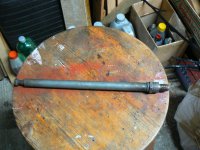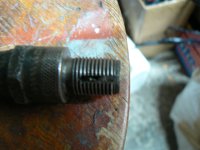Hello Diamond. Charlie's suggestion to check the plugs are actually the correct ones for the engine is a good place to start before, as I often do, assuming the worst and carrying out a thread repair which actually isn't needed! I think there's been at least a couple of different plugs recommended for the FIRE engine over the years. If the threads are definitely damaged too much to simply clean up with a tap or modified spark plug - I'll put a bit on the end about this when I've finished this - Then wire wound thread inserts are probably the cheapest and easiest to source. I have a small preference for solid inserts (like Time Sert) where something is going to be periodically dismantled and reassembled as I've experienced wire wound inserts "winding out" - but not often I will admit. However they are considerably more expensive to buy.
As you probably know, the FIRE engine plugs are angled slightly - two one way and two the other - and it's not unusual for someone not aware of this to cross thread them because they assume they should all be going in at the same angle.
Many years ago I "aquired" a 14mm spark plug helicoil kit:

I honestly can't remember where I got it, but likely to have been Musselburgh autojumble. I bought it to do a specific repair on a couple of damaged DAF twin cylinder air cooled engines with stripped plug threads - the smaller inserts were just right as they used short teach plugs. It then went to live in my tool cabinet and I just about forgot I had it until I started messing about with vintage horticultural machinery which use wee engines like the Briggs and Stratton on a lawn mower and also have short reach plugs which "ham fisted" hortuculturalists find nice and easy to over tighten and strip!
For those reading this who have never done a thread repair using this sort of kit, you have to drill out the remains of the thread with the recommended drill - for the 14mm inserts that's a 9/16 drill and you'll find it quite difficult to do this as the drill is quite big (see photo above) and tends to catch and pull. You have to have a very firm grip of the drill and be prepared to get quite "physical" with it to stop it wandering and making an oversize hole. Then you use the two taps - roughing first followed by finishing - to cut a thread into the opened out hole. These taps are very special because they are larger in diameter than the 14mm hole originally was (see the "wee" 14mm plug thread tap to the left of the drill) but their thread pitch is the same as that required for the 14mm plug. Then you load an insert coil into the inserting tool and wind it into the threads you've just cut. once you've fully installed the insert with it's top thread just below the surface of the casting, you have to wiggle and snap the tang off - look at the inserts in the picture, you can see the little stress concentration "nick" which helps it snap off at the right place - using something like a pair of long nose pliers and be prepared to swear mightily when you drop the little sod down inside the cylinder! One of the big problems with this job is to stop swarf from the drill and taps dropping down into the cylinder where it might get trapped down the side of a piston and do no end of mischief! I apply a goodly coating of high melting point grease to the tool tip and only cut a little bit at a time, then remove the tool, clean it's end, apply more grease and cut a little more. The swarf gets held in the grease - as long as you don't try to cut too much at one go - and then removed when you clean the grease off. The inserts are larger in diameter than the hole you're winding them into. The inserting tool compresses them as you wind them in so they are pushing out against the threads in the hole quite strongly once installed, the idea being that this keeps them in place.
If you think the the threads are not actually too damaged - which is unlikely as this engine has blown a plug or two out - you can try cleaning them up with a proper thread tap (the one to the left of the drill in the picture above, By the way the drill and that tap didn't come with the thread kit) or a modified spark plug like this:


I made this one to clean up the threads in an old Peugeot 504 many years ago - remember how deep the plug recesses were on them folks? - and it's been a very useful tool over the years.
You'll notice i "joked" about dropping the break off tang inside the cylinder? this can be quite a problem in other situations too so it's well wworth considering the slightly more expensive "Tangless" kits now available:
Discover the Heli-Coil tangless screw thread inserts from STANLEY® Engineered Fastening that offers savings in space, weight, & money through locking mechanisms.

www.stanleyengineeredfastening.com
By the way, while we are on this subject, it's well worth knowing about the repair inserts for caliper repairs now available. I had one installed on the Ibiza a couple of years ago and the kits have now come down in price a lot and are so easy to do that I'll be doing the next one myself:
& Many More M9. Brake Caliper Thread Repair Kit VW Golf Vauxhall Astra Ford Focus. Brake Caliper Guide Thread Repair Kit VAG VW Vauxhall Ford Seat Garage Tool Set. Kit includes 7mm hex key, stepped drill, M9 tap and ten inserts in storage case.".
www.ebay.co.uk
If you're looking at the kit and thinking - What? then look on line for "how to" videos.
I know you "old hands" will know a lot, if not all, of what I've talked about above but for those less well informed I hope the above has not been too boring.





